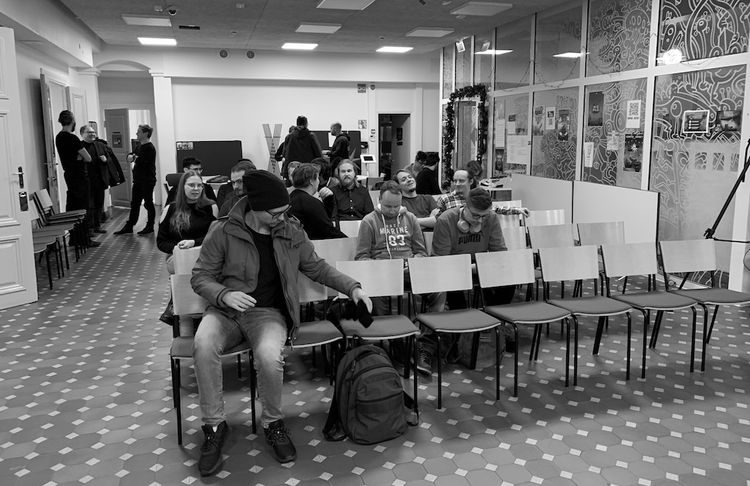How To Avoid Risks In A Gaming Startup

This article covers the topic of How to avoid risks in a gaming startup. It’s not easy out there for any games entrepreneur, even for the seasoned ones. First off, the biggest challenge that I see is that people are expecting to get revenues early on, but usually, it takes longer to see money flowing in.
When you want to have a profitable game, how do you minimize the risks involved? Game development has so many dead-end roads, and going from point A to point B isn’t just going to happen by itself. I’ve often reflected on projects in a way that “It looked like a path that we should go down”. But there are always risks involved. So what are those risks?
In April 2020, I did a webinar for Helsinki’s Aalto University on this topic. Here is the video from that webinar.
Below you can read more details on all these risks.
Risk #1 Not having a mission
The mission of the company states clearly what is the purpose of the company. Often times in gaming, people start companies because they have an excellent idea for a game, something that they are dreaming about. They’ve assembled a team of skillful co-founders and they start to work on the game.
Later, down the line, the game gets canceled with poor metrics. Now, what is the purpose of the company?

I recently wrote an article about Simon Sinek’s book, “Start with Why?”. In that article, I pointed out how important it is to find a real purpose for your games company so that you can align everyone around a common purpose. You want to have the founders, the company staff, and the players of the games, understanding the purpose, that it is meaningful in similar ways to everyone.
Questions that reveal the alignment between founders, staff, and players will be: “Why am I showing up to work?”, “Why am I playing these games?”
Risk #2 Hiring
You are either hiring too early or too late. I’ve often been given the advice that if you raise venture capital, you want to start hiring early so that you’re ready to grow your business quickly when the product is launched. I’ll make the distinction here for a games company, that hiring early means that you don’t yet have a game ready, and proven with good metrics. Hiring too late would be that you have already launched the game, with some solid metrics, but you don’t have all the people in place to run a live game.
Hire too early
Hiring early can cause lots of issues. Each new team member is a new node in a network of people. You bring in more people to a team, and you need to start communicating more, have more one-on-ones, spending time with people.
Do you need two game artists for the game, or would one be enough? Or what if you hired that Performance Marketing or player support specialist, but your game is still several months from soft launch? Can they wear other hats, meaning if they are capable of doing other jobs in your startup while you are still working on finding the first game that has solid metrics?
Hiring managers early is an interesting endeavor. If you hire someone from an existing industry job, who is used to being a lead or a manager in their previous job, what will do in your startup of five people? Will the be ready to wear several hats? Will they be able to take on different kinds of leadership challenges when the company starts to grow?
Hire too late
The best part about hiring too late is that you can build an expectation in the team that people are expected to do several jobs, wear several hats. The CEO needs to understand game design, and needs to ask the right questions about what should be done about the product, about marketing.
Here are a few observations on how you can achieve Hiring Late & Wearing Several Hats mode:
- Minimize business development This should be a given. When you don’t yet have a game that has proper metrics if doesn’t make sense to run around at gaming conferences. You can reach all the game publishers over intros and video calls. All the effort you can put into the company at the early stage is with your team working together, either at an office or if you work remotely, at your place of choice.
- Hire people who thrive when working independently Make sure you hire people who have the right attitude to get things done and figure things out on their own. Programmers who are waiting for game design, or specs on what metrics should be measured, will slow you down. Prepare things before you start the work so that these people can fly.
- Have stretch goals You should ask of your team to push for stretch goals. These are things that won’t be easy to achieve, but they break down the problems that you can face when reaching for the skies. You might not make it to Mars, but you can reach the Moon.
- Don’t wait for things to be perfect When you have a prototype with core gameplay in place, just launch it to get some metrics from player engagement. Then you’ll see the lay of the land, and you can ship the next build to try to improve the numbers from the previous release.
Hiring the wrong people
The one thing that I’ve noticed in running startups is that you won’t be able to change the people you hire. At least to the extent that they have certain traits that will stick with them and since you have a limited runway, you might not be able to change them in time before the money runs out.
The main observation is that they will change you, so keep this in mind. If you keep Brilliant Jerks, or ”Prophets of rage”, on your team, even when they weren’t the right fit, your lack of action will start to change the culture. Meaning that the company culture reflects the fact that it’s fine for toxic people to be on your team.
Risk #3 Fundraising
When I discuss with gaming founders on fundraising, they usually say that the biggest problem there is that investors just aren’t willing to believe in them and place a bet into the company. Most often, it’s the investors not believing in the game project that they have. I would always ask if they are already in the position to raise? Investors are happy to see the founders working on their company first without funding, and see that they are making progress on their own.
When thinking about the risks involved with fundraising, is the fact that you can’t raise the real problem? Actually, the more money you raise, the more problems you will have. First of all, do you already understand what the money is meant to be used for? Investor money is used to fuel the company, not a game project.
Some investors are considering gaming investments as lottery tickets, especially when they don’t have gaming experience. In these situations, gaming founders might be raising money from people who don’t have the experience but want to have control. The requirement of control will start to happen eventually, once you raise enough money, so be prepared to give some of the control to the investors. Or would you rather bootstrap the company for as long as possible?
One of the biggest risks comes from treating fundraising as a lifestyle upgrade for the founders. Suddenly you can pay salaries and take an expensive vacation again. An anonymous founder, recalling their experiences from their gaming startup “When we were more on the funding path, we were much less disciplined with our finances and a lot of the other details of the business. You just aren’t comparing yourself to profitable companies who aren’t raising.” The point is that if you raise money, it can be hard to focus on saving money and building the business with money coming from the paying players.
Before raising money, you should ask these questions:
- Can we still go for three months without raising money?
- Does it make sense to lose a stake in the company to investors?
- Can we do some projects on the side which pay our salaries, while we build our own on thing on the side?
Risk #4 The scale of the game
This goes back into discussing the big game. Early on, you don’t always know what it means to build a big game. If you look at the other games in the market, you’ll notice that the bigger games have a higher bar for quality and feature count.
If you’re building a big game into an existing genre, you’ll need to compete against everyone who’s already out in the market. Often times, the competition is made off of big companies with lots of money, who won’t suffer if their game fails.
To achieve the right understanding of the game, and how it performs, you’ll have to have a proper core and meta built out for a soft launch. An early soft launch will enable you to understand the appeal of the game. With this data, you can understand if you’ll get your marketing investment back from the players as they start spending. Often times, the player acquisition costs won’t come back in player spend, until you have content for day 30, day 60 and possibly day 90 of the player’s journey into the game.
For a hyper-casual game or any other smaller sized game, there will be less complexity and less moving parts. This enables you to build up the game quickly and test it within weeks of starting the development work.
If you look at the idle genre, it’s full of developers who know what they are doing with mitigating this risk. There’s Playgendary, Futureplay, East Side Games, Starberry Games, all focused on idle games. Why would they do this?

To mitigate the risk with the scale of the game, use the rule of 80/20. The rule means that you limit the amount of innovation that you put into the game, and use mostly proven solutions for creating games. Innovation is only 20%, and 80% is based on proven mechanics.
Kolibri Games used the 80/20 rule as well. They didn’t innovate in the user interface; they relied on a lot of conventions that worked, and then they added something new into the genre. It’s the same thing with East Side Games and their idle hit game Trailer Park Boys. They added a character collector mechanic into the game. This was s a novel feature that nobody had seen before in idle. And players loved it.
Back to Kolibri. For Idle Miner Tycoon, the Kolibri founders added lots of simulation gameplay, which was their 20, and the 80 was something that was already proven in other idle games. Adventure Capitalist is one of the earliest idle games that came out. The successful idle developers have been iterating on that, by adding their own small innovation.
I had Tim Reiter, one of the co-founders of Kolibri Games, on my podcast. He talks about the kind of development work they did for Idle Miner Tycoon. The founders of Kolibri were three guys from the university, and they wanted to start a games company. Their first game was a Boom Beach clone, which they worked on for a few months, but the game wasn’t working in playtesting, it just didn’t feel right.
They had started playing Adventure Capitalist, which had just come out. The Kolibri founders asked themselves: could we do something like this and one of the developers had an idea from the 80es from a miner game. They wanted to see if the miner mechanics would work in an idle game.
They started working and got the game ready in four months. Playtests showed that the game was working. They spent another two months to polish the game, and then launched it globally. The company started making a lot of money in eight months after starting the company.
To mitigate the risk associated with the scale of the game, the idle games and hyper-casual genre have been some of the best places to explore for new startups. After securing finances with smaller scale games, a company could go after a bigger game, with less financial risk. Without betting the entire company on a big idea.
Risk #5 Not being a learning machine
I think this is the biggest risk that newly founded games companies face.
You’ve just founded a games company and you have a clear understanding of what kind of a game you’re going to be making. You have a team of co-founders who are pumped by the idea and want to start building the game.
Six months later, the game starts shaping up, but it still doesn’t feel right. You feel that you still need to build more features to prove the game, so you stick to the plan and continue development work. After 12 months of work, the game is ready (enough) and it goes into soft launch. The metrics aren’t anywhere near what you were expecting. But no worries, we’ll need to tweak the tutorial and add another game mode. That will cheer up the players.
Three months later, you’ve done the changes. But the numbers aren’t improving. Your investors are wary and aren’t interested in putting any more money into your company. Three more months and the money runs out. The game didn’t make it. It wasn’t meant to be.
The failure could have been avoided if the founders would have been learning machines. Another name for this is the growth mindset. You want to learn. You want to understand why certain games are doing well. What are the underlying reasons? You know that you can do better if you know more. The growth mindset agrees with “Learning can significantly enhance my intelligence and I can achieve greater things.”

The opposite is a fixed mindset, which believes that “I have a fixed amount of intelligence”, and “I know everything I need to know about making games”. I’ve been in situations with game developers, where people talk about making games as a craft, but don’t get into applying learning, unlearning, and discovering new ways of uncover insights. How to get better at making games.
Seth Godin says that “The rationale for traditional education is that more learning gets you a better job, and a job gets you paid, which makes the learning a worthwhile investment. But what happens after you get that job? In some organizations, that’s the end of that. You might pick up experience and wisdom on the job, but the short-sighted organization may view ongoing learning as too expensive.”
Here are some obvious ways to build up your growth mindset. So that it becomes your superpower. And you leave behind your fixed mindset.
- Do market research.
- Play more games.
- Observe other people play the same games.
- Think and discuss why certain games work. Why are they doing so well and getting that amount of downloads? Do the same for all the games that don’t work.
This will mitigate the risks because you won’t be doing risky decisions because you will say that “I don’t know everything. I need to study and research the topic before I make the decision.”
Risk #6 Unrealistic expectations
You are hiring like crazy since you’ve gotten a lot of investor money. At the same time, you’ve received validation for your idea, through an investor saying “Yes”.
The technology needs to be built up, the market is not quite there yet, but the consensus is that the market will be there in a year. Is there a market risk associated? What is market risk? Is there a consumer need for your game? How do you figure that out?
Let’s talk about validation. When you have the money and the validation from influential people in the industry, you might not care enough about market risks.
In gaming, there are a few types of validation:
- Validation through metrics
- Validation through playtesting
- Validation through partnership
- Validation through investor money
- Validation through similar games (a gold rush happening)
To mitigate the risk of unrealistic expectations, the only validation to look at is based on the game’s playtesting and metrics. Sequels work as well when it’s proven that the target audience has a need for a sequel. The need has been identified with data, that backs the claim of the target audience being keen to play similar titles with a certain level of novelty. Decisions made on validation, which aren’t based on data, can cause severe consequences.

With my first startup in 2006, I was giving out press statements that “we are eleven (11) people now, and we’ll have tripled that by the end of next year.” What happened by early 2007 is that I had to lay off everyone and find new investors. I had the validation of having a yes from our initial investors. I thought that it was enough.When things get a bit out of hand, it can be hard to spot problems. How do you avoid these kinds of traps?
You should create a mechanism in the company to encourage uncomfortable information and “bad news” to be revealed. Ask your people constantly “What are the problems that we have?”. When you find a problem, figure out what caused it and how you can avoid the problem from causing issues, sometimes even catastrophic ones, for the company.
You can ask “What are the unaddressed problems that we are having with our game?” And when you find these problems, dig deep enough to understand what will happen if you don’t do anything about the problem. It needs to be genuine, showing curiosity to surface problems and deal with them effectively.
Risk #7 Publishing
When you are developing a game, the big question will self-publish or to find a publisher, who will publish the game. There are a couple of things I advise early-stage companies to do. 1) Don’t hire marketing people, and 2) Do a publisher deal with a well-known publisher when you have confidence in the game.
What does confidence look like? You develop the game for two months, playtest it yourself internally and externally. Once you feel confident with the game, and the playtests show that people are understanding and loving the game, you can move to create a build for a soft launch.
Get your session time numbers with your first soft launch. A while ago, Google Play shared an article on the first ten minutes being crucial indicators for player retention. Basically, if you have a game that keeps the players playing for over 10 minutes, and the longer they play on the first day, the more likely they are to come back to the game on day-1.
Teppo Soininen from the Ministry of Games was talking on the Elite Game Developers podcast about the pros and cons of working with or without a publisher.
The biggest pro is that you will get a large organization working for you to get the game out. But that is the optimal case. The best you can do is do your homework on the publisher so that you’ll not be surprised later on if and when things go south.
- The best publisher will move forward early with your game, once the see it for the first time. They can’t wait for numbers, because they can’t add value after the great numbers are out.
- Check their track record, has the publisher had hit games? If they’ve scaled up a game, they have the know-how and will know how to execute.
- Without a hit game, it’s harder to evaluate the publisher.
- Make sure the publisher has experience in the genre you are working in. Possibly even has a great portfolio fit for your game.
- Do they have a marketing budget to spend? If you have a hit, how will customer support and community be handled?
- Talk to the developers who didn’t succeed with the publisher. Why didn’t it work?
- Culture fit? Ask yourself: How would I and my team feel to work with the publisher?
Risk #8 Changes in the market
When we were starting to make Compass Point: West with Next Games in early 2013, I was asking myself that what will the market for our game look like in 2014 when it would go out. I believed that there would be a change, but I didn’t know all the angles that we should be looking at.
Another example is the Archero hype of 2019. I think it’s dying down now, and a lot of developers have killed their Archero builds. The big question here is how many games can target similar player needs, as there’s already one game that has met those needs and has kept doing so with constant updates.
Yet another example is the Battle Royale genre. You have Brawl Stars, Zooba, Armajet, Battlelands Royale, and many others. The target audience is already playing Brawl Stars, with Supercell knowing how to run user acquisition, with a big budget. Now Zooba’s developer Wildfire who just got a big round of $60 million in venture funding. Armajet also has raised several tens of millions. Then you have smaller developers, coming in and trying to do something. Should you build a shooter? No.
How can you mitigate this risk? There are several factors at play: Are the players already playing so many similar games? Does it make sense to go after the players? Can you really disrupt the incumbents?
Why wouldn’t you rather look at pockets in the market, where there is an opportunity. When the big guys aren’t looking yet, because they don’t believe that those kinds of games can make money. Idle games were a genre like this just a while ago. Of course, now it’s crowded. What is the next idle genre?
Risk #9 Game Designer risks
This is something that a lot of design people, who I’ve talked to, are curious about. Investors and outsiders can’t really point out this risk. You can have basically two types of designers.
Systems designers prefer to work on game economies and spreadsheets, but can’t build player need fulfilling core game loops. Similarly, if you have a great core gameplay designer, they would lack in systems design and couldn’t operate in Excel.
The best way to mitigate these risks is to make the whole team understand free-to-play. If you only have one person who is thinking about the game, what will drive players to play the game for day-30, day-90, and day-360?
Figure out why your whole team wouldn’t be interested in all of the design-related things and discussions. That is where the brilliant game design comes when you have the whole team contributing and discussing the game design.
Risk #10 Coder and artist risks
Technical debt is something that always comes up with you are moving quickly. You might be in the situation that you started the project by building a prototype that would prove the game. But then you realize that money is running out, and you only have two months of money left.
There is no time to refactor the code, we can’t start over with the source code, so we need to build and ship the game by writing on top of the prototype code. Then it ends up being spaghetti code, or other pasta like code.
You can prepare for these big expectations beforehand.
- Manage expectations on all sides Think early, that if you can get the confidence metrics of Day-1, then you have a happy problem: The prototype code was used to measure the early metrics and get evidence that things are working. You can now go and raise investor money or to make a great deal with a publisher. You can also let the coders start all over with new production code, and fix the technical dept.
- Build the right culture Engineers want to create code that they can live in for several years. The games are service-based and there will be several dozens of updates being done. The culture could become very sour if the code is so bad and everybody dreads to open Unity.
For the artists, how do you find work for them when things are progressing slowly? There might be a period where new art isn’t needed. Testing marketing assets, themes would make sense. You could have your artist building two kinds of marketing assets, to run an A/B test of the themes.
It’s all about managing the expectations. The artist would need to wear an unfamiliar hat, so make these new ideas clear to them early on.
Thanks for reading this article on risks for gaming startups. I suggest you subscribe to my newsletter where I’m sharing more on building successful gaming startups.





